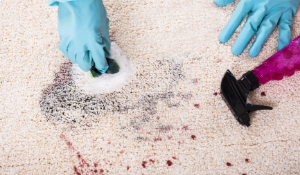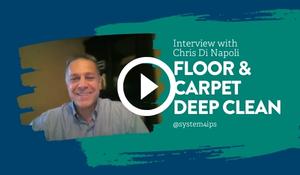Commercial Cleaning
Best Practices
Tips & Tricks
Facility Services
Property Management
Maintenance
Floors
Mind shift: Floors are high-touch surfaces causing cross-contamination
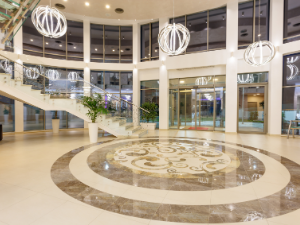
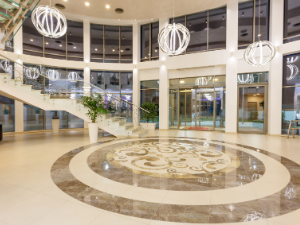
Floors are a conduit. When did you place something on the floor, then subsequently move it to a countertop or desk? Due to raised awareness over the past year, our behaviors have changed. Every industry has begun
cleaning for health, not just appearance. Just because it smells or looks clean, doesn't mean it's actually clean. High-touch objects, like door handles, stair railings, and elevator buttons are being wiped down and disinfected multiple times per day. But what about floors? Are they being overlooked?
Yes, floors are high touch
Studies and evidence-based reports reveal floors as the largest reservoir for contaminants. Indoor environments are a challenge when it comes to reducing germs. Many respiratory diseases are transmitted when individuals cough, sneeze and even speak, releasing aerosolized contaminated droplets. These droplets are eventually landing on surfaces via the pull of gravity. These surfaces (reservoirs) serve as a means of transmission. All the discussion on high-touch surfaces focus mainly on door handles, faucets, keyboards, elevator buttons, and light switches.
What about flooring? Floors are the largest reservoir for these contaminated droplets. As you'd guess, these droplets do not remain only on the floors. They are distributed throughout facilities on shoes, socks, bottoms of purses, bags, backpacks and pets. With this in mind, flooring is a high-touch surface and needs to be included in sanitizing and disinfection routines.
The American Journal of Infection Control shared a report that evaluated how floors play a role in
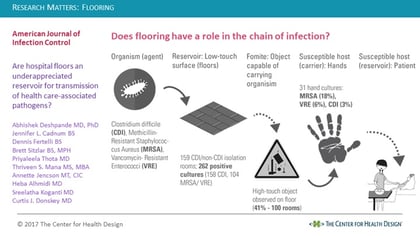
the chain of disease transmission. Evidence shows 41% of high-touch items (cell phone chargers, bed linens, towels, etc) are in contact with floor surfaces.
The study's author, Abhishek Deshpande, MD, PhD told Buildings.com, "Limited attention has been paid to disinfection of floors because they are not frequently touched. The results of our study suggest that floors in hospital rooms could be an under-appreciated source for dissemination of pathogens and are an important area for additional research."
Using the wrong cleaning product could damage your flooring
First, determine what type of floor is being cleansed. Using a good-quality product with neutral pH may be enough. But, introducing a cleaning solvent with a high pH, could permanently damage flooring materials and finishes.
Cleaning, sanitizing and disinfecting are not the same processes. Once you assess what your workplace requires, choosing a product for your specific type of floor is next. Disinfectants are designed for pre-cleaned, hard, nonporous surfaces like terrazzo, vinyl, and vinyl composition tile (VCT).
.png?width=300&name=February%20blog%20floors%20high%20touch%20surface%20(3).png) It's critical to first clean to remove dirt, dust and debris, which act as barriers, before applying a disinfectant. Sanitizers are made for porous and semi-porous surfaces like carpet, wood and other textiles. Reading the cleaning directions on the manufacturer's label is necessary to ensure proper procedures are followed to ensure efficacy and protect your investment in one of the most visible elements, your flooring.
It's critical to first clean to remove dirt, dust and debris, which act as barriers, before applying a disinfectant. Sanitizers are made for porous and semi-porous surfaces like carpet, wood and other textiles. Reading the cleaning directions on the manufacturer's label is necessary to ensure proper procedures are followed to ensure efficacy and protect your investment in one of the most visible elements, your flooring.Dwell time is key
First comes the cleaning, then comes disinfecting. Each step takes time, something that is always running short. To disinfect, start with the right concentration of the product, then follow instructions regarding the proper dwell time stated on
.png?width=300&name=February%20blog%20floors%20high%20touch%20surface%20(1).png) the label. Dwell time is the amount of time the surfaces must remain wet with the product for it to be effective. Recommended dwell times are outlined on the product's label. However, dwell times are affected by the method of delivery - fogging, wiping, and spraying, etc.
the label. Dwell time is the amount of time the surfaces must remain wet with the product for it to be effective. Recommended dwell times are outlined on the product's label. However, dwell times are affected by the method of delivery - fogging, wiping, and spraying, etc.
Following the proper guidelines comes at a cost
Cleaning budgets in 2020, increased for companies and organizations.png?width=300&name=February%20blog%20floors%20high%20touch%20surface%20(2).png) across many different industries. Rising costs can be a challenge while trying to balance the need to follow proper guidelines. The majority of every dollar spent is attributed to cost of custodial labor, rather than cost of actual cleaning products. Budgetary restrictions are part of every business. Weighing the costs versus the health and liability consequences is constant concern.
across many different industries. Rising costs can be a challenge while trying to balance the need to follow proper guidelines. The majority of every dollar spent is attributed to cost of custodial labor, rather than cost of actual cleaning products. Budgetary restrictions are part of every business. Weighing the costs versus the health and liability consequences is constant concern.
.png?width=300&name=February%20blog%20floors%20high%20touch%20surface%20(2).png) across many different industries. Rising costs can be a challenge while trying to balance the need to follow proper guidelines. The majority of every dollar spent is attributed to cost of custodial labor, rather than cost of actual cleaning products. Budgetary restrictions are part of every business. Weighing the costs versus the health and liability consequences is constant concern.
across many different industries. Rising costs can be a challenge while trying to balance the need to follow proper guidelines. The majority of every dollar spent is attributed to cost of custodial labor, rather than cost of actual cleaning products. Budgetary restrictions are part of every business. Weighing the costs versus the health and liability consequences is constant concern.The bottom line
We all know the five-second rule. Food lands on our kitchen floor at home, we ask: Is it safe to eat? But when you're in the workplace, if something like your backpack or purse is on the floor, you may ask: Do I need to wash my hands after picking this up?
By adding flooring to our list of high-touch surfaces, we better understand the chain of infection and keep our environments safer and healthier. Take a proactive approach. Include flooring in heightened cleaning protocols and infection control policies.
.png?width=300&name=February%20blog%20floors%20high%20touch%20surface%20(4).png)
How we view cleaning has been altered due to COVID-19. Cleaning for appearance only is long gone. Visibly seeing cleaners in action will be a long lasting trend. Seeing professional cleaners tending to highly visible floor surfaces will assure employees and customers of a healthy indoor environment.
If you have experienced a COVID-19 singular case or outbreak amongst your staff or at your facility, call System4 IPS and schedule your disinfection service today. Our team listens to your needs, requirements, and timing. See our many satisfied customer testimonials and public Google ratings.

